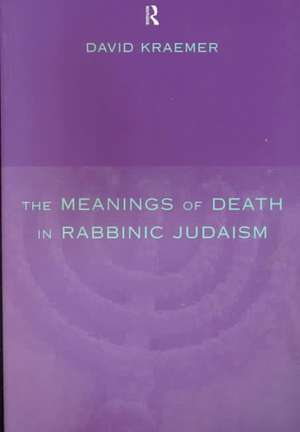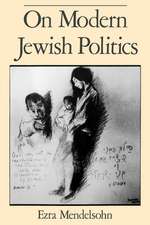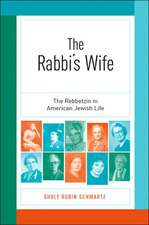The Meanings of Death in Rabbinic Judaism
Autor David Kraemeren Limba Engleză Paperback – 23 sep 1999
The author examines the earliest canonical texts - the Mishnah, the Tosefta, the Midrashim and the Talmud of the Land of Israel. He outlines the rituals described in these texts, from preparation for death to reburial of bones and the end of mourning. David Kraemer explores the relationships between the texts and interprets the rituals to uncover the beliefs which informed their foundation. He discusses the material evidence preserved in the largest Jewish burial complex in antiquity - the catacombs at Beth Shearim. Finally, the author offers an interpretation of the Rabbis' interpretations of death rituals - those recorded in the Babylonian Talmud.
The Meanings of Death in Rabbinic Judaism provides a comprehensive and illuminating introduction to the formation, practice and significance of death rituals in Rabbinic Judaism.
| Toate formatele și edițiile | Preț | Express |
|---|---|---|
| Paperback (1) | 356.66 lei 6-8 săpt. | |
| Taylor & Francis – 23 sep 1999 | 356.66 lei 6-8 săpt. | |
| Hardback (1) | 981.60 lei 6-8 săpt. | |
| Taylor & Francis – 23 sep 1999 | 981.60 lei 6-8 săpt. |
Preț: 356.66 lei
Nou
Puncte Express: 535
Preț estimativ în valută:
68.28€ • 70.97$ • 56.61£
68.28€ • 70.97$ • 56.61£
Carte tipărită la comandă
Livrare economică 06-20 februarie 25
Preluare comenzi: 021 569.72.76
Specificații
ISBN-13: 9780415211840
ISBN-10: 0415211840
Pagini: 184
Dimensiuni: 156 x 234 x 13 mm
Greutate: 0.32 kg
Ediția:Critical edition
Editura: Taylor & Francis
Colecția Routledge
Locul publicării:Oxford, United Kingdom
ISBN-10: 0415211840
Pagini: 184
Dimensiuni: 156 x 234 x 13 mm
Greutate: 0.32 kg
Ediția:Critical edition
Editura: Taylor & Francis
Colecția Routledge
Locul publicării:Oxford, United Kingdom
Public țintă
Postgraduate and UndergraduateRecenzii
'His analyses of the pertinent Rabbinic narratives as well as laws are systematic and cogent, a coherent set of questions coming to bear at each point in his presentation' - Jacob Neusner, The Jerusalem Post 18/02/00
'This book contributes significantly to the growing interdisciplinary field of death studies...' - Douglas J. Davies, University of Durham, Journal of Semetic Studies
'This book will be a source of enjoyment and inspiration to anyone interested in the encounter between Buddhism and Christianity and indeed in inter-religious encounter in general.' - 'Elizabeth J. Harris, Reviews in Religion and Theology
'David Kraemer ... provides an interesting, yet highly critical academic insight into Jewish practices as expounded in rabbinic literature.' - Rabbi Martin van den Bergh, Mortality
'This book contributes significantly to the growing interdisciplinary field of death studies...' - Douglas J. Davies, University of Durham, Journal of Semetic Studies
'This book will be a source of enjoyment and inspiration to anyone interested in the encounter between Buddhism and Christianity and indeed in inter-religious encounter in general.' - 'Elizabeth J. Harris, Reviews in Religion and Theology
'David Kraemer ... provides an interesting, yet highly critical academic insight into Jewish practices as expounded in rabbinic literature.' - Rabbi Martin van den Bergh, Mortality
Cuprins
1 The presence of death 2 Jewish death customs before the rabbis 3 Early rabbinic death-practices: The evidence of the Mishnah 4 Early expansions and commentaries: The testimony of the Tosefta and Tannaitic Midrashim 5 Jewish death-practices in reality: The catacombs at Beth Shearim 6 Jewish death-practices in early Byzantine Palestine: The Yerushalmi and Aggadic Midrashim 7 Law as commentary: The Bavli on death and burial 8 The Bavli interprets the mourner 9 Post-Talmudic developments in Jewish death-practice 10 A personal theological postscript
Notă biografică
David Kraemer is Professor of Talmud and Rabbinics at the Jewish Theological Seminary of America in New York.
Descriere
This is the first study of the death and mourning practices of the founders of Judaism - the Rabbis of late antiquity. The author outlines the rituals described in early texts and interprets them to uncover the beliefs which caused their foundation.











